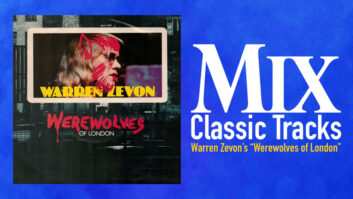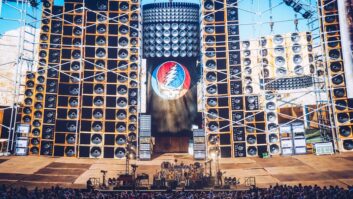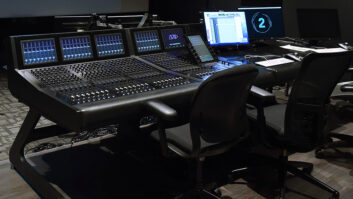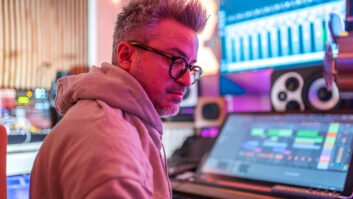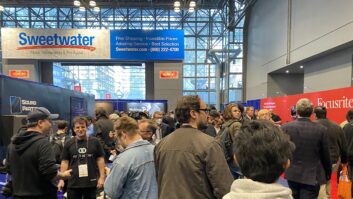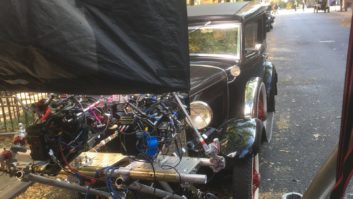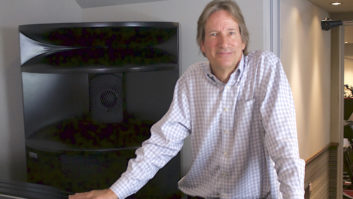IMAX Film Showcases Rock Legends, Today’s Superstars — Up Close and Live!
There’s a point near the beginning of ALL ACCESS: Front Row. Backstage. LIVE!, the new IMAX film debuting this month, where Sting recounts a meeting years ago with Miles Davis. “You’re the one with the big head,” Miles told him. “I saw you in that movie. Your head filled the whole screen.” It gets a puzzled look from Sting and a big chuckle from the audience. Just imagine if Miles had been around to see Sting seven stories tall onscreen, playing live to an audience of 10,000, in multichannel playback.
With all due respect to the Rolling Stones, who pioneered the music-for-IMAX genre on their Steel Wheels tour in 1991, ALL ACCESS is the ultimate in music-driven movies — large-format, stunningly clear visuals, 12,000 watts of 6.0 channel digital sound, multiple performers. For the artists, it provided a chance to showcase their live talents to an extended fan base and to be a part of the permanent record. For music fans, many of whom often sit in row ZZ, it’s a chance to get up close and personal, to get as close to the coveted All Access pass as many are likely to get.
ALL ACCESS is the brainchild of Jon and Peter Shapiro, a couple of brothers with a passion for music and film. Jon, a self-described studio rat since age 14, when he assisted Ray Bardaini at Minot Sound, White Plains, N.Y., went to Northwestern University’s Film School in the late ’80s, then on to Hollywood, where he produced, among other projects, Richie Rich in 1994. Peter, a film producer who has put out numerous documentaries, including Tie-Dyed and a portrait of Ken Kesey, today owns the venerable music club Wetlands Preserve in New York City. “I had a music production background and went into film, and Pete had a film background and went into live music,” Jon Shapiro says. “We had this interesting mixture where he put his chocolate in my peanut butter.”
About two years ago, the Shapiros began thinking about bringing the energy of live performance — with multiple acts — to the IMAX screen. Jon had become enamored with the format when, as an 11-year-old, his parents took him to the Smithsonian to see the pioneering IMAX film To Fly. He followed the development of the format, and as the technology advanced, he saw the opportunity to showcase music as no film had.
“We wanted to give the audience an All Access pass to these unbelievable performances, taking them backstage, somewhere they can’t go. Much like Everest took you to the top of Everest. Much like other IMAX films that take you to outer space or swimming with sharks, all things you can’t do in normal life. The Stones did the performance aspect incredibly well, and I love the movie. They went for scope. But we wanted to do something different. We wanted to give people a more intimate experience, where they really feel like they are front row, or backstage, or behind the stage.”
THE LINEUP
The Shapiros first approached IMAX in early 1999, and the initial reaction was something along the lines of: Are you guys crazy? You’ve never made an IMAX film, and you’ll never pull this one off without label support. “So we took their advice and went ahead anyway,” Jon Shapiro laughs. “But we did tell them that if we made the film, they would distribute it, because they have the prowess and the name brand.”
Because they did not want label influence, the Shapiros next drew up a wish list of artists and began approaching them individually, using the IMAX experience as a selling point. It proved a relatively easy sale.
“We knew that we wanted multiple acts, and we also knew that we wanted different generations paired up in unique ways on a song that would never be repeated anywhere else — ostensibly a pairing of a mentor and a protégé,” Shapiro explains. “We first went after the legends. Our first call was to Carlos Santana, then Sting, then B.B. King, then George Clinton. To our surprise, Carlos indicated interest immediately. This was right before his star started to shoot through the roof with Supernatural. To his credit, and to his manager’s credit, he stuck with it throughout. We filmed Santana’s performance of ‘Smooth’ with Rob Thomas the day after they won all those Grammys. The energy and the magic in that room…it was the pinnacle moment, I thought, of everything that had happened to him, not only with the past year, but his career, and you’ll see that come across in the film.”
After Sting, George Clinton and B.B. King signed on, the Shapiros started going after the next generation and pulled in Sheryl Crow, Dave Matthews Band, Mary J. Blige, Kid Rock, Macy Gray and Moby. For King’s performance, they went three steps deep.
“Pete knew this jam-band scene from his club,” Shapiro says. “He thought it would be great to get Trey Anastasio, the lead singer of Phish, then back them up and supply a groove with The Roots, a Philadelphia hip hop band. Sos we have this intergenerational, intercultural blend, where we took B.B.’s classic blues standard ‘Rock Me Baby’ and did a jam band, hip hop version of it. None of them had met before they performed in the movie, and the chemistry is just fantastic.”
THE VENUES
The logistics of putting together what are essentially unique one-offs of A-list talent seems staggering. To accommodate schedules, the majority of the shoot took place in the Grand Olympic Auditorium in downtown L.A., near the Staples Center, where the 2000 Grammy Awards were being held. The idea was that most of the artists would be in town and could drop in for on-camera interviews and a few performances during the following week.
The Grand Olympic, built in the 1920s, seats about 8,000, but the Shapiros brought in their own production design and knocked it down to about 1,000 capacity, “to create the ultimate club vibe.” The audience was let in free of charge, and they literally are right up on the stage — front, back and sides. The design was optimized for a five-camera shoot, with Steadicam and a new development, the IMAX-compatible TechnoCrane. Mics were hung all over the venue, including the hallways, to get that thump-y bass sound all concertgoers recognize. The shoots at the Grand Olympic were recorded to Sony 48-track digital by Guy Charbonneau of Le Mobile Recording.
Three other venues provide a backdrop for the film. Sting, performing “Desert Rose” with Cheb Mami, was filmed at the PNC Bank Arts Center in Holmdale, N.J., in front of 10,000 people. The Dave Matthews Band, with Al Green, was shot at Soldier Field in Chicago, in front of 60,000. Both were recorded by David Hewitt of Remote Recording Services, again to 48-track digital. Finally, Sheryl Crow, in what was presented as an artist in rehearsal, was shot on the biggest soundstage at Sony Music Studios, New York City. It’s just her on a stool with a guitar performing “If It Makes You Happy,” recorded by Elliot Scheiner. The performance is breathtaking.
Scheiner, who came aboard on a recommendation from Sting’s manager, Miles Copeland, was actually involved in the project front to back. He sat in the remote trucks for the recordings, took the tracks back to Presence Studios in Connecticut (see sidebar), and mixed the songs in 5.1 and stereo for DVD and CD release. He then delivered stems on DA-88 to Mark Wright at CBC Studios Toronto for the final film mix.
THE IMAX MIX
Mark Wright’s background is in music recording, but he got involved with IMAX back when he put together the trailers for the Rolling Stones at the Max. He has since mixed Fires of Kuwait, Africa: The Serengeti and many others, the most recent being the immensely popular Cyberworld 3D. He, too, got involved early on in the process, visiting the venues and offering suggestions for the interview footage, as well as meeting with Scheiner to discuss surround concepts and stem delivery, which is common in the film world, though not in music mixing.
“Stem mixing was very important so that we could have some flexibility in the film mix as we worked against the visual,” Wright explains, pointing out that the IMAX format, while 6-channel, does not have a discrete subwoofer. “Elliot has a style of mixing that is brilliant for 5.1 — very dynamic, very engaging and very surround. We wanted to take that forward and apply it to the film mix, where, besides the visual, you have to worry about the volume of the room, the playback curve and the calibration of different-sized IMAX theaters.”
Impressed by the fidelity of the original recordings and the quality of Scheiner’s music mixes (which included effects), Wright admits that he didn’t do much in the way of treatment or remixing. Mainly, he supported the visuals and played with perspective and transitions.
“We would have, say, a basic rhythm stem mixed in 5.1, then a guitar stem separate from the band stem, then a vocal stem, then a sync audio stem with room mics and crowd,” Wright explains. “Then, depending on the song, we might have a background vocal stem or keyboard collages — that gave us the flexibility. On Santana, for example, we had his guitar track separate from the vocal, separate from the band. That way we could add some processing on the guitar, variable to a couple of slides going into solos, which we actually wrapped around the room to add dimension. And when Carlos goes center-image with the mirror effect, that gave us the capability to support the center a bit more with the lead instrument.”
“Smooth” served as the test demo to prove that the translation from 5.1 surround to 6.0 IMAX would work. Shapiro, Scheiner and Wright then took a Beta SP Version of the Avid output, walked down the street to the Paramount IMAX theater in Toronto, with a 6-track fold-down DA-88 of the stem premix, and ran the segment at show level. It worked beautifully.
Wright then went back to his Neve console at CBC, with Claude Fortier monitoring, and began mixing the entire film, in sequence. Pre-production had called for consistency in sample rates and reference, so they had very few conversions. The stem material was kept digital throughout the process; with the Otari Universal Format Converter, they were able to go TDIF to S/PDIF. The entire 64-minute film was mixed, again to four stems, to two 48-tracks, with the final filling a single reel of Sony 48-track, 16-bit at 44.1 kHz — the IMAX delivery requirement.
Still, Wright did not merely serve as a transfer bay for Scheiner’s mixes. He worked on transitions into and out of the interview footage between performances, and he occasionally enhanced the songs to work for the larger venue. Kid Rock, perhaps, provided the best example.
“I really liked the Kid Rock energy; the performance is right on,” Wright says. “But for IMAX, Jon and I both wanted something more. We tried some low-bottom, trying to get impact, but we both felt that we had overworked it in a way that wasn’t needed. So I tried digging into the audience tracks, and I found a microphone that had quite a bit of P.A. spill in it. I went for some super-lows in that microphone and dialed in a bit of trash, that 2k trash that you can get out of a drum kit — the cymbal and hi-hat. All of a sudden, that was it. Then for the vocal, I did something I don’t usually do, where I dug out a bit of the fundamental, around 500 cycles, and pumped that a wee bit to give it its niche in the mix.
“For Sheryl Crow, then, the idea was to feel the power of her acoustic guitar and her vocal — feel the strumming and feel the presence of her voice,” he continues. “We did that with just a hint of perspective, where on the longer wide shots, she would be slightly more ambient in her vocal, and then as we come up on a pull-in, we would go a bit dryer so that you have the intimacy. Not in a big way. Subtle and very tasteful.”
There were plenty of challenges on the film, mainly having to do with maintaining sync throughout the edit and conforms, a problem that is more noticeable in the large format. (Though Wright has an eagle-eye, noting dropouts down to the frame, he praises Soundmaster’s SmartSync system.) The interview footage, where each artist talks backstage about music and influences and the future, were shot 35 mm and blown up. Because the dynamics of the speaking voice butted up against the power of the stage, transitions were crucial and could have presented problems at the mix.
“These artists are in the moment,” Wright says of the backstage interviews, which were edited in Soundscape and fired off the DAW on the mixing stage. “They may go very quiet and then get quite expressive. So we have to even out those dynamics, because on a large screen with high SPLs, you don’t want quite that dynamic range. In the premix, I would spread it out. I prefer it centered, but then I ‘shoulder’ it so that in the left and right speakers, the interview dialog will be there but at a lesser level — about 10 dB down. I also delay it very slightly to the left and right.”
ENJOY THE SHOW!
From the opening four-minute collage, where the cacophony of preshow setup (rigging, rolling cases, set construction, etc.) is interspersed with a Moby underscore and, again, interspersed with the interview to the show-stopping finale as Al Green walks offstage at Soldier Field, ALL ACCESS is a one-of-a-kind tribute to the power and joy of music. It wonderfully captures that adrenaline rush that accompanies top performers at the top of their game — in a live setting.
“We wanted to grow into this movie,” Wright says, “keep it a bit real. At soundcheck, they’re not quite on their game as they would be when the crowd is there. It’s a bit looser, a bit rawer, so we kept the audio quality that way, too. A little off-mic, a little low-fi. Then we go into the interview and we just pop out — the crowd is there, the fidelity is there, the impact is there. They’re on their game, and they just let it hit. It’s a great moment, and I like the way the transition worked. That’s what it’s like when you go to a concert and they’re on and they let loose. That’s the moment we wanted.”
Tom Kenny is editor of Mix.

